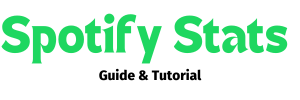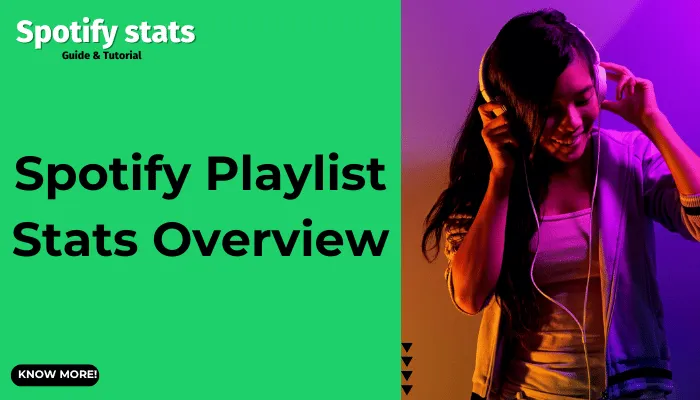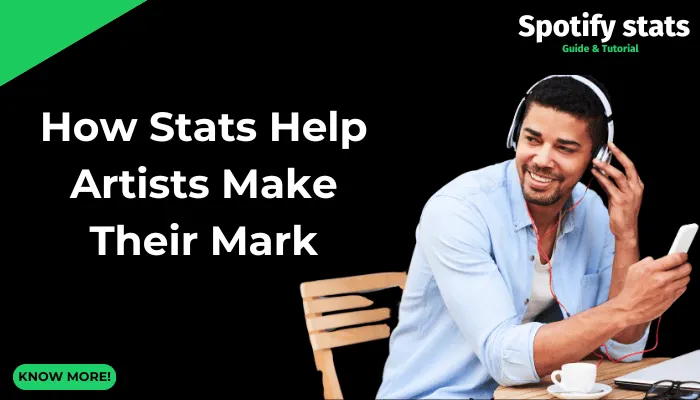You wanted to know about Spotify playlist stats? Well, They are the heart and soul of Spotify, whether it is a well-thought-out mix for that ideal summer journey or just your best pump-it-up tracks. Revealing fascinating insights into how people listen to music and the significance of playlists.

Let’s be honest; music is personal. The songs we choose express our feelings, stories, or even identities. This guide goes through Spotify Songs Stats explaining what they are, different kinds available, and why they matter for both casual listeners and playlist creators.

Spotify Playlist Stats Overview
Spotify Playlist stats could also be regarded as report cards behind the scenes. They indicate various metrics that demonstrate how people interact with your playlists. To some extent, they show just how many people listen to them, which content resonates most with them, and where this falls in general on the Spotify listening landscape.
Key Metrics to Track
The following is a sample discussion on some of the main Spotify playlist stats:
- Followers: This metric shows the number of individuals who have saved your playlist to their library so that they can find it easily again later on. A large follower count suggests that a wider community appreciates your selection.
- Plays: This stat simply logs all instances when someone has played through at least part of your playlist or several times up to the end track.
- Likes: Which are an indicator that someone enjoyed either the selection or overall vibe associated with your playlist.
- Skips: However, not that positive, it can still be informative. If certain songs are skipped a lot, this might indicate that they do not quite fit the playlists’ theme or flow.
- Average Listen Time: This metric tells you how much time listeners typically spend on your playlist on average. The longer the average listening time, the more unified and engaging the playlist is.
Those are just a few of the main Spotify playlist stats. Additionally, depending on which platform or tool you use to analyze your playlists, you may find other metrics such as listener demographics, peak listening times, and even devices commonly employed to access your playlist.
How Stats Can Supercharge Your Spotify Playlists
Have you ever wondered what makes some playlists on Spotify resonate in a magical way with you while others make you want to skip? The answer may be hidden in the power of Spotify songs stats. These secret metrics go far beyond play count, providing useful guidance on playlist engagement.
You can turn your playlists into tactical masterpieces that draw crowds and enhance your musical reputation by using information from Spotify playlist stats. Let’s get started and see how data can supercharge your Spotify playlists!
For Casual Listeners:
- Discover Hidden Gems: Through statistics of plays and likes in these playlists, one can identify hidden gems from Spotify vast library.
- Refine Your Listening Experience: This could mean that some particular tracks were being frequently passed during playbacks and this information will certainly help in making a better selection when curating new ones.
For Playlist Creators:
- Get a Feel for How Good Your Playlists Are: The numbers can give you an idea of how well people are responding to your playlists. If your follower count is high and the play rate is good, it means that your playlist is reaching out to many people.
- Improve on Your Weaknesses: One thing that can help you is analyzing skips and average listen time. It could be something as simple as changing the order of tracks on your playlist or removing those with high skip rates or including songs from different music genres.
- Track Growth Trends: Observing Spotify songs stats and Spotify playlist stats over a longer period will enable you to see the development of your playlists and note trends in listening habits. By using this data, it becomes easier to create more compelling playlists in the future.
Consider Spotify playlist stats as a hidden weapon that enables you to keep up with the constantly changing music world. By getting to understand these metrics, one can become a better listener who knows what they want to hear and who wants their songs played exactly when they want them played.
How to Access Your Spotify Playlist Stats
So, do you fancy deciphering some codes concerning Spotify playlist stats? Don’t worry music lovers! This section contains everything you need to know about unlocking this great resource of information.
A. Discovering Native Stats within Spotify
Spotify itself may not offer detailed analytics for playlists but it does have some useful basic playlist stats. Here’s where:
- Go through Your Playlist: Start by opening the Spotify app and then go through “Your Library”. There select “Playlists” before making a choice on which one you would like to study further.
- Press Three Dots: Carefully look at three vertical dots placed next to the name of the playlist in question and click on them so as to get access to some options provided under that heading.
- Menu Drop Down: Among the listed options, you will notice an entry called “Playlist Stats” or something similar to that. By selecting it, you will be able to discover several basic metrics for your playlist.
B. Getting a Glance at Data
Here are some things you might see:
- Follower Count: This is the number of people who have saved your playlist in their Spotify library so they can easily access it later on.
- Total Plays: Basically, this number tells how many times a user has streamed your entire playlist (or most of it).
Although Spotify offers only a couple of these directly, they give an initial direction on how your playlists perform.
C. Digging Deeper with Third-Party Tools
In order to get more insights about your playlists, try third-party statistics for playlists. These tools typically offer much richer and varied Spotify playlist stats than the native ones.
Below are some common options:
- Stats for Spotify: As a free web-based tool, Stats for Spotify allows you to connect to it using your Spotify account and view basic analytics such as top artists, genres, and even the most played playlists within various time frames.
- Spotistats: In addition, Spotistats is another free website that shows an illustration of listening habits including playlists data. You will find information such as trends in followership and individual song popularity within these lists.
- Soundcharts: Lastly, Soundchart is a premium service meant mainly for professionals in the music industry which provides detailed analysis on playlist demographics including listener profiles and how playlists compare against one another regarding performance.
D. Right Tools
However, if you are a casual playlist maker, any free option like Stats for Spotify might suffice. For instance, those with more serious hobbies about playlists or seeking an opportunity to beat the rest of the competition can consider purchasing premium software such as Soundcharts.
Third-Party Tool Disclaimer: Always check that these third-party tools are reputable and secure before connecting them to your Spotify account.
This will change everything from being a playlist creator into being a data-driven maestro where you make playlists which resonate well with your listeners.
E. Skips
Skips can have both positive and negative implications. Some skips here and there are normal, but a high skip rate on a particular song may mean that it ruins the flow of the playlist or does not match with the general theme. When analyzing songs with high skip rates, you should consider either taking them out or rearranging your playlist.
Additions to Other Playlists
This stat is sometimes buried in other reports provided by third-party tools, and it is worth exploring. If other curators are adding your music to their playlists, then it shows that what you have chosen is of good quality and has great appeal. It will also expose your playlists to a wider audience.
Remember: There’s no magic formula for interpreting Spotify playlist stats. Instead, they must be considered in conjunction with each other and within the context of your genre, target listenership group, and purpose.

How Stats Help Artists Make Their Mark
We have delved into Spotify playlist stats from the perspective of listeners but what about the artists? Well, here is good news for musicians and music creators; get ready to roll that’s how much power playlist statistics hold for your career.
A. Reaching New Audiences
Think about your song being played through millions of headphones on well-curated playlists. That’s one of the wonders of having Spotify playlist stats, especially if you are an upcoming artist. Here is how Spotify songs stats can improve your reach and fame:
- Catch the Curator’s Eye: Playlist curators have a lot to go through whether they are Spotify’s own editors or independent tastemakers. When they analyze their playlists’ statistics, it helps them notice songs with high engagement metrics (plays, saves, low skips). So if this song has these attributes then it becomes a frontrunner for being included in the track listing which exposes you to a new audience altogether.
- Track Your Playlist Journey: Did a specific playlist land you a significant number of new followers or streams? By monitoring placement and related statics for such kind of playlists, an individual will be able to determine which ones effectively boosted his/her music promotion efforts on Spotify. It is by so doing that one gets to know where exactly he/she needs to concentrate his/her outreach efforts while at the same time targeting certain types of playlists.
B. Stats as Your Secret Weapon
However, playlist statistics are not only a hook for curators. As an artist, you can use them to improve your own playlists and build up a loyal following:
- Organize Homogeneous Collections: High skipping rates among particular songs might mean that they do not go well with your playlist’s framework. Use stats to reveal these culprits thereby facilitating better flow of your playlist.
- Take note of Fan Favorites: Check the songs in your playlists that receive consistent play counts/plays and saves/likes. Consequently, this information will be useful when selecting future songs and may even shape their personal style.
- Cooperate with other Musicians: A closer look at the stats for certain playlists can tell you a lot about artists who have similar fans. Link up with them so as to be able to create another list hand-in-hand or chance upon new talents whose audiences shall become yours too.
C. Experiment and Track Results
Innovation is the key to success in the music industry. Therefore, try out different playlist themes, genres, and even types of cooperation. When you make any changes to your playlist, keep an eye on corresponding playlist stats.
Regular analysis will show what resonates with your audience members most thus allowing you to sharpen up your approach as far as pieces of music are concerned so that they could fall into the right ears.
By relying on Spotify playlist stats, musicians can transform themselves from unknown artists into industry influencers within a very short time period. So remember; next time you go through your music data, it’s not just about numbers but also a way to unlock global connections for your songs.
Tools for Deeper Analysis
Although these techniques work well for basic Spotify playlist stats, there are some others that go further:
1. Heatmaps
They visually represent which parts of your playlists get listened to most. As such, you will identify where people typically stop listening as well as make adjustments for better engagement along this line.
2. Demographic Data
Some advanced tools provide insights into the demographics of your playlist listeners such as age, location, listening habits among others. As such they help one design playlists appropriately depending on their audience.
3. Song Analytics
More detailed song data can unveil interesting patterns at an individual level. You could know who among artists or what genres are mostly listened to by your audience thereby guiding future song selection towards these aspects on any other track listing on Spotify.
4. Choosing the Right Tools
The best analysis tools depend on your needs and budget. Free options like Spotistats offer basic data visualization while premium services like Soundcharts provide in-depth analytics and competitor comparisons.
Conclusion
Here’s a world of information to be found in Spotify playlist stats. Don’t let your Spotify songs stats be a guessing game. If you are a casual listener looking for undiscovered songs or an artist trying to attract their audience, then this is where you find all these figures that will enable you to choose wisely and enjoy your Spotify experience.
By gauging popularity and engagement or refining your selections for optimal flow and audience resonance, you can choose placements that will introduce your music to fresh audiences.
Well, play your favorite song, examine those figures, and so on; let yourself become the mastermind of playlists!
